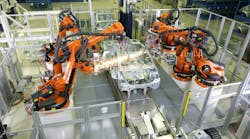The past year has been significant for robotic process automation (RPA). The discussions and chatter have not only picked up significantly surrounding robots, automation, and financial efficiencies, but companies are also starting to put real dollars into action. In fact, a recent study by Deloitte found that 53% of organizations have started their RPA journey, a number that is expected to increase to 72% by 2020.
(Credit: Deloitte)
We’re in the middle of a fourth Industrial Revolution, one that will see the rise of the digital workforce. We invest in technology to solve problems but, in short order, things around us change; it’s complicated to upgrade, buy, or build technology to cope with the change. This causes us to fill gaps with human intervention because we are still the best innovators on the planet. RPA helps to fill those gaps, quickly bridging between technology, process, and people with bots.
But before companies embark on a specific RPA path, they first need to consider the implications of a digital workforce and how this will impact their overall business. The focus should be on desired outcomes and business goals and not on the technology. RPA can handle the manual, data-driven, tedious tasks that are commonly handled by human workers. However, processes utilizing RPA have been limited by the human cognitive factors. Bots just aren’t as smart as humans (yet)!
As companies identify the goals they hope to achieve, there are three things we should expect to see from RPA in 2019:
Convergence and speed will dominate. The convergence of RPA and artificial intelligence (AI) will gain speed. Organizations are going to automate manual, repetitive processes and gain new efficiencies. With these early wins, enterprises will start to envision how they can replace human judgement with digital workers. This shift in 2019 will force bots to more readily utilize natural language processing (NLP), optical character recognition (OCR), intelligent character recognition (ICR), and machine learning (ML) technologies. Eventually, companies will combine RPA and these technologies with IoT. Think about an Alexa or Siri interface to your process automation.
This move will impact a variety of industries. Imagine a trucking company that has tremendous amounts of data, which today requires a great deal of manpower to complete. Truckers arrive at a facility with a full payload for drop off, and workers in that ecosystem are often beholden to a traditional large binder that manually captures the information and exchange of goods.
Now imagine a scenario where there is a beacon on the truck, one that communicates with a beacon at the destination about who the driver is, and what type of goods he or she is carrying. Instead of paperwork, data is transferred wirelessly into an enterprise resource planning (ERP) system in real time. A bot picks up the work and quickly moves data from one system to another and notifies the necessary parties. This results in a quicker identification of data, along with more quality and efficiency.
Global proof of concepts emerge. While RPA is still in its early stages, 2019 should be a year of accelerated growth with a huge uptick in adoption globally. Organizations will test RPA with Proof of Concepts and Pilots, and will look to institutionalize RPA by creating RPA Centers of Excellence (CoE) and adopting governance programs.
(Credit: Deloitte)
Global retailers with large amounts of inventory have a surplus of structured and unstructured data. As thousands upon thousands of invoices or other manual paperwork pile up, this becomes a huge problem. However, one piece of smart bot technology (e.g., ICR), along with RPA, can help immediately compare and identify dates, invoice numbers, customer history, etc.
The technology can be trained to do what humans have done. Rather than having people logging into a variety of different systems, bots can log on to multiple systems simultaneously, scan, copy, input, and transfer data. The result is incredible efficiencies and economies of scale that translate to bottom line business results in both human and bot capital.
It wasn’t long ago that flat screen technology was all the rage, but availability and pricing made it unattainable to the masses. We’re in a similar stage today with RPA. Early RPA adopters are climbing up the bell curve of adoption that will soon spike as more competitors, better technologies, and reasonable pricing emerge. Once distribution escalates, expect healthcare and ecommerce industries to move quickly ahead, which should open the door for other industries.
(Credit: Deloitte)
Don’t worry, humans still matter. Despite everyone’s excitement around bots, humans still matter. Already this year, many of the RPA software vendors offer free training, with some offering free community editions of their software. These free resources make it easy for anyone to learn how to build bots for their personal use on their personal computer desktops, which is a great first step toward whetting your appetite for RPA.
Process and technology changes from day to day, and that’s one reason why RPA is so important and game-changing—it typically sits on top of existing technology without needing large-scale investments and changing infrastructure, security, and governance. 2019 will be a great year for RPA…and the rest of us.
RPA still has many gaps and still isn’t the end-to-end solution for automation. While RPA does a lot of the heavy lifting and automating out redundant, tedious tasks, human judgement is still needed to complete many of business processes today.
After all, we humans are still the best innovators on the planet.
Scott Willhite is a client partner at Cognizant Softvision, helping to lead the Global RPA Guild Practice Area.




